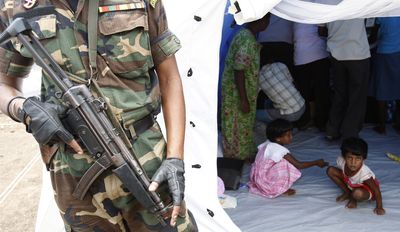Sri Lankan refugee camps sober U.N. chief
Civil war leaves 300,000 displaced

MANIK FARM, Sri Lanka – U.N. chief Ban Ki-moon flew over the scorched and deserted landscape of Sri Lanka’s last battlefield Saturday, and urged the government to let more aid reach displaced Tamils complaining of hunger and separation from their families.
The secretary-general said his tour of a hastily erected displacement camp housing more than 200,000 people “was a very sobering visit, very sad, very moving.”
Ban was the first major international figure to visit since President Mahinda Rajapaksa declared victory over the Tamil Tiger rebels on Monday, crushing their dream of a separate state for the Tamil minority.
Nearly 300,000 Tamil civilians were uprooted from their homes in the final months of fighting and sent to dozens of government-run camps in the north. Most of them were packed into the sprawling Manik Farm camp, which lacks adequate sanitation or medical facilities for people who Ban said had undergone inhumane conditions under fire.
“The situation, which I have seen for myself, is very, very difficult. It’s a real challenge,” Ban said. “There is clearly a limitation. The United Nations should try to fill this gap.”
Refugees told Ban they lacked rice, sugar and cooking oil, and were not allowed to leave the camp, which is encircled by barbed wire and guarded by soldiers stationed across the grounds.
Men and women were scooping water from a well and bathing awkwardly in the open air, trying to maintain some privacy.
“Overcrowding must be addressed,” Ban said.
After meeting Rajapaksa later in the city of Kandy, Ban acknowledged “the challenges facing the government are huge, but I appreciate their leadership.”
Ban called on the government to give aid groups unfettered access to the camps and welcomed Rajapaksa’s promise to resettle the bulk of the displaced by the end of the year.
Aid groups have appealed to the government to allow the displaced more freedom, but military officials say it is too dangerous to let them out because rebels could be hiding among the civilians.
Ban’s helicopter flight over the wasteland along the northeastern coast offered a grim view of the final battlefield. The earth was scorched and the area was pocked with craters. Cars and trucks were overturned and bunkers were dug outside tents clustered in the area.
Human rights groups and international officials accused the government of heavily shelling the area, densely populated with civilians, in the last weeks of the war. The government denied using heavy weapons.
Rajapaksa pledged to ensure the nation never be divided again.
“We shall from now, meet all such needs to build a just and free society,” he said.
However, aid groups have complained about conditions at the camps, accusing the government of restricting access and detailing outbreaks of disease because of poor sanitation.
Mark Cutts, a senior U.N. humanitarian officer, said the Manik Farm camp was erected almost overnight and is the world’s largest displacement camp.
“There’s 200,000 people here. This is a very overcrowded place, a very big place, and there’s a lot of work still to be done. Conditions, you can see, they’re very basic,” he said.
The Tamils, 18 percent of the population, claim systematic discrimination and harassment by the Sinhalese majority.
“Now that the long decades of conflict are over, it is time for Sri Lankans to heal the wounds and unite without regards to ethnic and religious identity,” Ban said at the airport early Saturday on his arrival.
The U.N. chief’s impressions will also be of concern to the U.N. Human Rights Council, which has planned a special session on Sri Lanka on Monday at its headquarters in Geneva, Switzerland.
According to private U.N. documents, at least 7,000 civilians were killed in the final months of fighting in the war.